Art walk
Center Route A
Walk 5 km, 1 hour
Welcome walker! Do you like walking and want to be inspired by the cultural treasures of Uithoorn? Then try this route that takes you past the statues that our city is rich in. With an accurate description. The points we pass match the points on the digital art card that is available.
This is center route A that takes you from the Center stop line 25 to the Bus Station stop in about an hour. From there you can take the tram or, if you still have energy left over, walk with Centrumroute B back to the Centrum stop. Water at hand? Just walk.
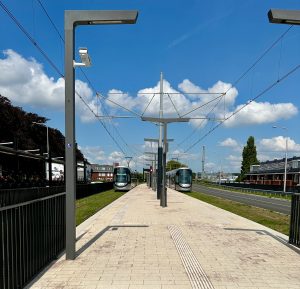

A. Station Uithoorn Center
Line 25 from Amsterdam-Station Zuid ends in Uithoorn at Het Spoorhuis, near the Amstel. A wonderful opportunity to enjoy a cup of coffee before the walk begins.
- When you are ready, walk back along Het Spoorhuis on the Stationsstraat.
- Then immediately turn left into Stationsstraat. A little further on you can see the beautiful Amstel with the Oude Spoorbrug on the left. A national monument from 1912.
- Before we get there, first turn right at Willem-Alexanderpoort.
- Further on you can see the first work of art behind the terrace of Italian restaurant La Nuova Riva.
B. The Towing Barge
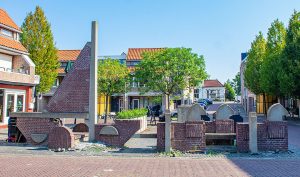
The Trekschuit is a reminder of the Masonry Championship that took place in 1985. A period in which the center was significantly renovated but also changed in architectural style.

C. The Cheese Dealers
- We now walk again towards Willem-Alexanderpoort, and continue under it towards the Amstel.
- We will then arrive at the Wilhelminakade. Turn right there. From spring, the terraces are full and invite you to a place overlooking the port of Uithoorn.
- The Wilhelminakade turns into the Market Square with the Library and the many restaurants on the right.
- We then arrive at the former town hall of Uithoorn where Geniet is now located on the Amstel. There we see the following two art objects.
The Cheese Traders of Kees Verkade (1941 - 2020)
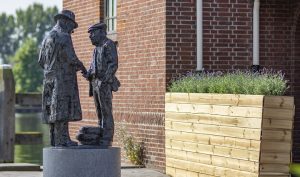
For dairy production, Uithoorn was one of the main villages in the region. The river village was then mainly accessible by boat. In 1906, the Condensed Milk Company began producing condensed milk. Later acquired by the Campina Melkunie. It closed its doors in 1997.
The cheese and butter market on Thursday dates from 1858, the grain and seed market on Friday from 1876. The livestock market on Wednesdays was merged with the cheese market in 1919. This cheese market ended in 1960. The statue was made by Kees Verkade and offered to Uithoorn on August 29, 1981 by the Willem Meindert de Hoop Foundation.
The Merciful Samaritan
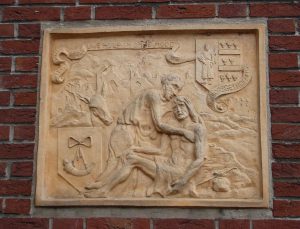
A little further on on the wall of the former town hall hangs a plaque by artist Piet Peters (1889-1950). He was a painter, ceramist and sculptor.
The baked plaque shows two male figures in relief, with one having stepped off his donkey to support the other. In the upper right corner is the coat of arms of Vierlingsbeek, at the bottom left the coat of arms of Uithoorn. In the background you can see destroyed houses. At the top is a banner with the text:
‘AS A THANK YOU FOR YOUR HELP IN OUR NEED OF WAR-TO-WAR VICTIMS’

D. Queen Wilhelmina
- We go right the Pr. Irenelaan and pass the Marktkraamwinkel.
- Continue to the park and turn right into Oranjelaan.
- At the end turn left again into Emmalaan. We come to two images.
Vital force - Sjra Schoffelen
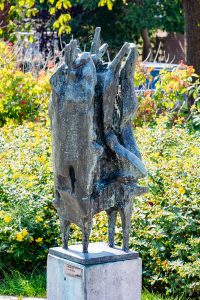
The art object is in the Oranjepark where we are now. This bronze art object from 1967 in which human figures take center stage is by Sjra Schoffelen (born 1937). It shows a great degree of expressiveness, rhythm, movement and growth, like much of his work from that time
The art object consists of three parts that enter into a confrontation. The two outer parts enclose, as it were, the third part that forms the core. This core tries to rise above the other two parts. In this growth process, the different parts are indispensable for each other.
Queen Wilhelmina - Charlotte van Pallandt (1898-1997)
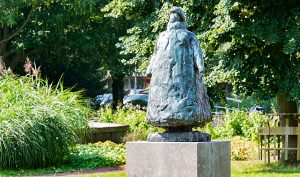
On the corner of Emmalaan and Prins Hendriklaan we see the bronze art object of Queen Wilhelmina standing in an unyielding position looking at everything that is happening in Emmalaan and Julianalaan. How symbolic: close to her mother Emma and her daughter Juliana a little more relaxed. Three queens linked together as the House of Orange in a once royal district.
The art object was donated by the burg. Kootfonds on the occasion of the opening of the new town hall.

E. Earth and Water II
- Via the Prins Hendriklaan we walk past the Oranjepark back to the Pr. Irene Avenue.
- We turn left and then come to the next image. It’s in the park on your left.
Earth and Water II - Nic Jonk (1928 - 1994)
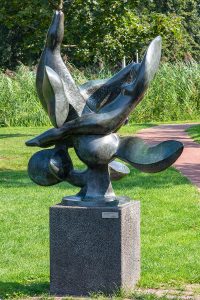
This art object is a memorial on the occasion of the liberation festival in 1980 (35 years).
In this bronze statue on a stone pedestal, a female figure and a dolphin (or other large fish) can be recognized. It is signed ‘Nic Jonk 1976’. The sculptures of this sculptor are clearly recognizable by their soft curved round shapes.

F. The Red Fox
- Walk towards Dorpsstraat, along the Vomar.
- Turn right into Dorpsstraat, further on you will see the Amstelplein.
- Turn left to the narrow Amstelstraat.
- Continue to the Irenepad.
- Take the pedestrian tunnel. It runs under the Kon. Máximalaan through.
- The Irenepad turns to the right and becomes the Schans.
- Turn left to Schoolstraat. You will find your destination on the right.
De Red Fox - Gerard van Hulzen (1946 - 2015)
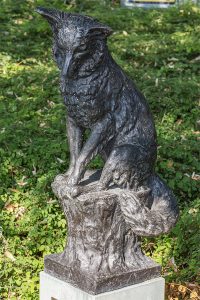
The statuette De Roode Vos aan de Schans opposite the Courthouse still recalls the disappeared tobacco industry of Uithoorn. A similar statuette once adorned the facade of the Uithoorn tobacco factory. De Roode Vos was the brand name of plum tobacco.

G. Municipal coat of arms Uithoorn
- Walk west on the Schoolstraat.
- Turn right to stay on Schoolstraat.
- Go straight with the Amstelplein on the right.
- Cross the Laan van Meerwijk.
- The renewed coat of arms of Uithoorn can still be seen on the facade of the town hall.
Municipal coat of arms Uithoorn
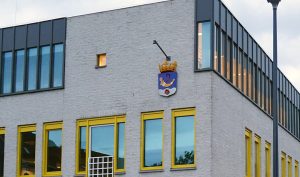
The change of the coat of arms is the recording of a water wave that symbolizes the Amstel and the image of a rose that stands for the floriculture of De Kwakel. Uithoorn and De Kwakel together form the municipality of Uithoorn. The Village House De Quakel is located in De Kwakel itself.

Shortened route along Zijdelmeer
You can now choose the shortened route along the Zijdelmeer by turning left to the Boterdijk. You are missing 4 art objects. This option includes a beautiful walk along the Boterdijk and between April and October you can visit a surprising heem garden on the first Sunday of the month!
This garden on the Boterdijk is named after the last resident, Bram de Groote. He created the garden as an English landscape garden, but gradually it became a heem garden with area-specific plant species. The special trees have always been preserved. The garden is open from 13.00 to 16.00. The entrance is at the working barn of Landschap Noord-Holland on the Elzenlaan. There you can store your bike. Admission is free.
- Walk the route over the Boterdijk to the Elzenlaan.
- Turn right into Elzenlaan.
- Continue it to the Watsonweg.
- Cross Watsonweg and turn right on the other side.
- Walk until you get to (H) Steel Plastics.
- Pick up the main route there again.

Meerwijk route
True art lovers choose the extended part through Meerwijk, towards De Kwakel. The walking time remains almost the same.
- You continue your route on the Korte Boterdijk, towards the Kofschip.
- Turn left to the Kofschip
- Turn right towards Laan van Meerwijk
- Turn left towards Laan van Meerwijk
- When you are back on the Laan van Meerwijk, turn right.
- Continue walking to a slight curve to the right. There you will see the following image on your right.
Three from Stone - Gerard Höweler (1940 - 2021)
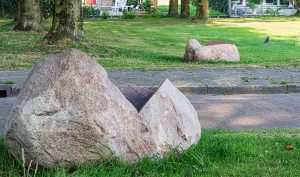
The art object consists of three stones the largest is ocher gray and weighs about 1,300 kg, the middle one is gray-black with large white spots and weighs 700 kg the smallest is light reddish brown and weighs 600 kg.
- Then follow the Laan van Meerwijk again until you see the Waternimpf just past the Elbe, left in the water.
Waternympf - Ria van Vught (1945)
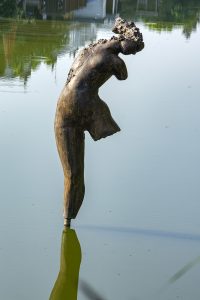
The art object was placed as part of a sculpture route through Meerwijk. (around 1989). The images of Lia van Vugt are not primarily thought from nature, they are independent objects that follow their own rules. The most important rule is that the image can be viewed from all sides, from below, from above, from the side. It is about how the image intervenes in the space around it. Van Vugt strives for a certain ‘abstraction’. This is a consequence of her effort to create an autonomous image, an image that is independent of a prescribed context and that has itself as a reference.
- Follow the Laan van Meerwijk again until you see school community De Eendracht on the right.
Elephant - Ella van Veen (1945)
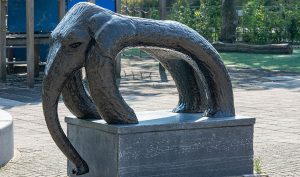
The art object is on the playground. Versatile play plastic in the shape of an elephant. The opening in the trunk is a marble jar, a jumping rope can be hooked in at his tail (and a hand less is needed when jumping string), in his back is a large hole to throw a ball in or crawl through.
She followed her education at the National Academy of Fine Arts in Amsterdam. Ella is known for, among other things, the Indies Monument in the Broersepark in Amstelveen and the Memorial for India and Korean soldiers Wall of Silence at Beukenhof cemetery in Schiedam. The monument Gordel van Smaragd at Zorgvlied cemetery in Amsterdam is also hers.

To 'In Balance'
We are now going to the last image in Meerwijk. You follow Laan van Meerwijk that turns into the Polderweg.
- Follow the Polderweg until it turns left.
- You go straight on the Blue Goose.
- Then turn right down the Grey Goose until you can turn left.
- There you go on the Korte Polderweg.
- About halfway through you can see the image on the left in the water.
In Balance - Rob Cerneüs (1943 - 2021)
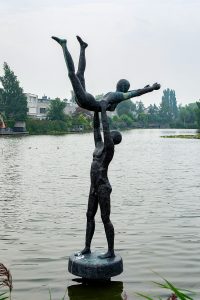
Art object of a man, holding up a woman by her waist. The art object was placed in Meerwijk to complete the new building. The art object was unveiled on December 3, 1997 and is in the water on the Korte Polderweg.
From 2009 to 2013, Rob Cerneüs made the art column Uit de Kunst for the program Van Zuks Dus for RTV Noord-Holland. In it, he visited artists, exhibitions and museums together with reporter Ron Flens. In 2011, RTV Noord-Holland devoted a two-part documentary to Cerneüs and his work.

H. Steel plastics
After In Balans we arrive at the Watsonweg from the Korte Polderweg. Here we combine the route again if you have walked along the Zijdelmeer.
- Follow the Watsonweg to the corner with the Kon. Máximalaan.
Steel plastics - Josje Regout
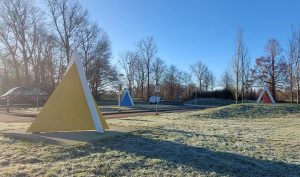
The art object was designed and placed in response to the construction of the current town hall. The colors of the triangles matched the color use of the original design of the town hall (white-red-yellow-blue). In 2022, the triangles were moved to Watsonweg where they will come into their own through more space. The reason for the relocation was that the village center was being renovated and there was no longer a place for such a large work of art.
The artist lives in Noorden and now breeds old apple varieties.

I. Mother and child
We have arrived at the last stage of this walking route. We cross the Kon. Máximalaan to the Zijdelweg.
- We have to be on the right side so cross a second time.
- Then walk to the Den Uyllaan.
- We turn right and continue to the Beellaan.
- There are two statues along the Den Uyllaan.
Mother and Child - Ek van Zanten (1933)
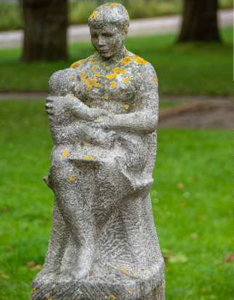
Van Zanten followed an education at the Rijksakademie of visual arts in Amsterdam from the age of fifteen, where he was taught by Piet Esser, among others. One of his classmates was Jan Wolkers. In 1953, he received a scholarship for a follow-up study at the École Nationale d’Architecture et des Arts Décoratifs (Higher School of Fine Arts) in Brussels. In 1955, Van Zanten participated in the third edition of the international sculpture exhibition at Park Sonsbeek, with his sculpture Dame in Stoel. He won the Prix de Rome that year, which allowed him to work in Rome for two years. Back in the Netherlands, he initially lived in Amsterdam and from 1961 in Naarden. He received the Culture Prize from the municipality of Hilversum in 1963 for his image of Europe and the bull. In addition to his work as a sculptor, Van Zanten was a part-time teacher at Academy Minerva in the city of Groningen in 1971-1988.
The Spear Thrower - Arthur Spronken (1930 - 2018)
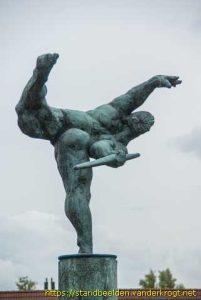
Spronken was the son of Jan Nicolaas Spronken, cigar manufacturer and Bertha Hertz. In his youth, Spronken was influenced both by the horse love of his father and grandfather, and by the sculptor Paul Schmalbach, where he cuts figures in wood. He was prepared for trade, but eventually went to the Kunstnijverheidsschool in Maastricht, where he was taught by Charles Vos and Harry Koolen, among others. He studied here from 1948 to 1952 and then left for Milan for a year to do an internship at the Accademia di belle Arti di Brera. There he was taught, among other things, by Marino Marini, a specialist in the field of horses in sculpture.

Uithoorn bus station - stop tram line 25
This is where our walking route along the art objects of Uithoorn-Centrum ends.
- On the Den Uyllaan we walk a little further to the Beellaan.
- We’re going into it on the left.
- We continue the Beellaan to the Cort van der Lindenplein.
- There we turn right and stop at the Uithoorn bus station.
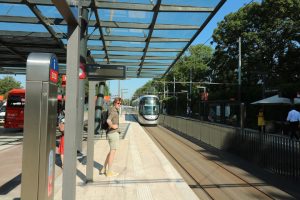
You can now take tram 25 back to Amstelveen or Amsterdam. You can also extend this hiking route with the Kunstroute Centrum B (available soon). This route along even more works of art will take you back to the Centrum van Uithoorn stop.

